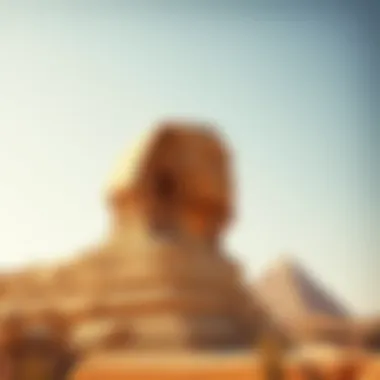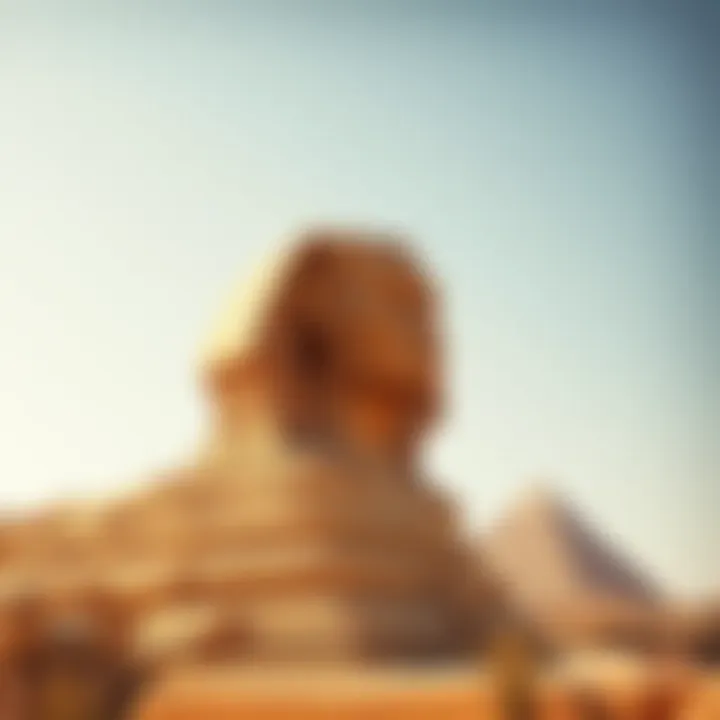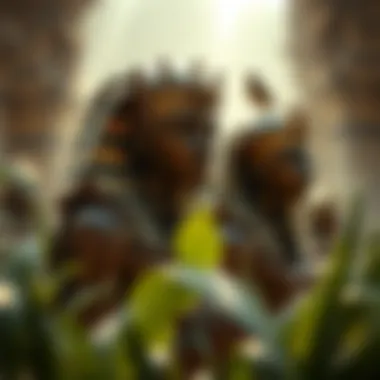Exploring the Wonders of Ancient Egyptians


Nature Topic Overview
The ancient Egyptians were not just builders of monuments and creators of art; they were also deeply intertwined with the world around them. The geography of Egypt, dominated by the Nile River, played a pivotal role in shaping their civilization. Picture a land where life revolves around a single, mighty river, surrounded by vast deserts. This connection to nature was not merely incidental; it dictated their agriculture, trade, and even their social structure. The Nile flooded annually, bringing rich silt to the land, making it fertile for crops. This phenomenon was celebrated in their culture, as the river was seen as a lifeline, much like the veins in a body.
Ancient Egyptians viewed nature not as something to be conquered, but as a vital part of life. They observed the seasons, understood the environment, and created their own sustainable practices. They revered various animals, believing that gods took on different forms within them. For instance, the cat was sacred to the goddess Bastet, and the ibis to Thoth. Not only did animals play significant symbolic roles, but they were also crucial in everyday life, helping with herding and agriculture.
By examining these aspects, we can see how closely connected ancient Egyptians were to their surroundings. Their ability to adapt and flourish in such a setting provides fascinating insights into their civilization.
Fun Facts and Trivia
- Did you know the ancient Egyptians loved board games? Senet was popular and is considered one of the world’s oldest known games!
- Mummification was not just for the rich; many Egyptians believed preserving the body was key to the afterlife.
- Cats were highly regarded; harming one could lead to severe punishment because of their association with divine protection.
- The Great Pyramid of Giza was the tallest man-made structure in the world for over 3,800 years!
Visuals and Interactive Elements
Imagine crafting your very own papyrus scroll with ancient Egyptian symbols! You could write your name using hieroglyphs or even create a map that connects various important locations in the Nile Valley. Incorporating visuals like images of temples or illustrations of daily life can also enhance learning.
Wildlife Explorations
The banks of the Nile teemed with various species that were crucial to everyday life. Crocodiles lurked in the waters, revered yet feared. Ibis waded through the shallow banks while fish darted below the surface.
- Crocodile: A powerful creature that symbolized strength and protection. They were both feared and worshipped.
- Ibis: Known for its long, curved beak, it was associated with wisdom and often depicted alongside the moon god, Thoth.
Exploring these animals helps us appreciate the ecosystem ancient Egyptians lived within. Imagine taking a virtual zoo tour where you could learn about how these species adapted to their environment! Quizzes like matching the animal to its significance in Egyptian mythology could be a fun way to solidify that knowledge.
Environmental Awareness
Conservation and sustainability were instinctive to the ancient Egyptians. Their reliance on the Nile taught them the importance of maintaining a balanced ecosystem. Leverage that lesson today:
- Planting trees or creating a small garden at home teaches respect for nature.
- Participating in local clean-up drives helps protect community spaces.
Encouraging children to work together promotes teamwork and responsibility. The connection between the past and present highlights how small actions can ensure environmental protection.
DIY Nature Activities
Hands-on activities can bridge the gap between learning and experience. Here’s a few ideas:
- Build a Mini Pyramid: Use sugar cubes or clay to create a little pyramid, showing how ancient Egyptians built their grand structures.
- Nature Crafts: Using leaves and twigs, create art projects inspired by hieroglyphs, allowing children to express creativity through historical context.
- Stargazing Adventure: Organize an evening under the stars to observe celestial bodies as ancient Egyptians did when looking to the sky for guidance.
These activities not only enhance understanding but also encourage a hands-on approach to learning about history and nature.
Prelims to Ancient Egypt
The tale of ancient Egypt presents a tightly woven fabric of human achievement, cultural expression, and natural wonder. This article tells the story of one of the earliest civilizations, where sand, sun, and the mighty Nile created a landscape for extraordinary social and cultural developments.
Understanding ancient Egypt is not just about digging up artefacts or deciphering hieroglyphs. It’s a chance to witness the intersection of nature and human ingenuity. From the grand pyramids standing tall against the desert sky to the intricate daily lives of its people, every facet provides insights into the past that still resonates today.
Additionally, it's crucial to highlight how the interplay of geography and resources shaped their civilization. The laying of social foundations also found favor in their beliefs and art, which was as much a reflection of their society as it was a projection of their values. Thus, ancient Egypt’s importance in history cannot be overstated, as it gives us a glimpse into the early aspirations of humanity and how those ambitions shaped our modern world.
Geographical Context
The geography where ancient Egyptians flourished was a unique blend that played a pivotal role in molding their civilization. Nestled along the banks of the Nile River, the ancient Egyptians found a life-giving force that became the backbone of their society. The region is largely arid desert, but the Nile carved its way through, creating fertile land that could sustain agriculture. This contrast was perhaps the catalyst for their agrarian focus, leading to advances in farming practices.
The ancient Egyptians were keenly aware of their geography —
- The desert served as a natural barrier against invasions.
- The Nile connected them with trade routes to other regions, enriching their culture.
- Natural resources like stone for pyramids and minerals for tools were readily available.
Clearly, ancient Egypt's geographic configuration helped them create a society that could thrive against challenges and utilize their environment efficiently.
The Nile River's Significance
The Nile River was more than just a water source; it was the heartbeat of ancient Egypt. Its predictable flooding patterns provided nutrient-rich silt, ensuring that crops could be planted twice a year. This abundance transformed agriculture into a cornerstone of their economy. The following highlights demonstrate the river’s colossal importance:


- Agriculture: The lifeline of a nation rests on its ability to feed its people. The Nile allowed the development of farming, leading to the growth of settlements and, eventually, cities.
- Transportation: The river acted as a natural highway. Trade between different regions flourished as goods and ideas moved back and forth on boats that glided over the water.
- Culture and Religion: The Nile influenced religious beliefs. Many gods and goddesses were directly related to the river, seen as both a giver of life and a source of power.
All in all, the Nile was interwoven into the very fabric of Egyptian life, shaping not just their civilization, but also how they viewed their world.
Social Structure of Ancient Egyptians
The social structure of Ancient Egypt was a complex web that held the civilization together, much like the Nile River nourished its lands. This structure not only defined relationships among people but also emphasized the roles each individual played in maintaining the society. Understanding this hierarchy is crucial to grasp the values and beliefs of the Ancient Egyptians. Each class was interconnected, with the Pharaoh at the top dictating laws, while farmers and laborers formed the backbone of their economy. This arrangement provided a sense of order and stability to a society that thrived for thousands of years.
Pharaoh: The Supreme Leader
At the pinnacle of Ancient Egyptian society stood the Pharaoh, often regarded as a divine figure. The Pharaoh was considered a god on earth, a mediator between the gods and the people, which bestowed him immense power and authority. He was responsible for maintaining Maat, the ancient Egyptian concept of truth, balance, and cosmic order. This made his role crucial in both everyday life and the afterlife; the Pharaoh’s actions were believed to directly affect the Nile floods and harvests.
The Pharaoh managed the construction of monumental structures, including the iconic pyramids. These grand architectures served not just as burial sites but as a testament to the Pharaoh’s power and a bridge to the divine. He had a retinue of advisors, generals, and priests to assist him, ensuring that each aspect of governance, from warfare to religion, was performed efficiently. In a nutshell, the Pharaoh was not merely a ruler; he was the heart and soul of Ancient Egypt.
Role of Nobility and Priests
Beneath the Pharaoh was the noble class, made up of wealthy landowners, government officials, and high-ranking priests. These individuals played a significant role in the administration of Egypt. They oversaw tax collection, land distribution, and even participated in significant religious ceremonies. Nobility enjoyed privileges, but they were also expected to uphold the Pharaoh’s authority and serve the community through governance and religious duties.
Priests held a unique position in society, often possessing immense knowledge of rituals and laws. Their influence rivaled that of the nobility; they were the intermediaries between the divine and the earthly. Priests managed temples, which served as centers of worship and economic activity. They conducted daily rituals, ensuring that gods were pleased and maintained harmony in society. Therefore, their role was crucial in maintaining the balance that the Pharaoh aimed to uphold.
The Lives of Common People
The majority of Ancient Egyptians were common people, comprised of farmers, laborers, and artisans. Often overlooked, these individuals were the foundation of the economy. Farmers worked the fertile land alongside the Nile, cultivating crops like wheat and barley, sustaining not only their families but the entire kingdom. Their labor was essential during the flood season, when the Nile’s yearly rise brought nutrient-rich silt that made the land productive.
Artisans also contributed significantly to society. They crafted goods ranging from pottery to intricate jewelry, showcasing the artistic talent present in even the lower echelons of society. Although common people had limited political power, their skills and hard work were invaluable, allowing civilization to flourish.
"The strength of a civilization lies not only in its leaders but in the hands of its workers."
Everyday life for these individuals included communal activities, festivals, and rituals that reinforced their connection to both each other and the divine. They had their own practices and customs that fostered a sense of community despite their often challenging circumstances. Their stories, though sometimes overshadowed by grand narratives of the Pharaohs, are essential to understanding the richness of Ancient Egyptian civilization.
Innovations and Contributions
The innovations and contributions of the ancient Egyptians played a crucial role in shaping not only their society but also the world as we know it today. Their inventive mindset led to advancements in various fields, ranging from architectural feats to medical practices. These contributions reflect a civilization that was deeply aware of its environment, showcasing how innovation was often driven by the need to adapt and thrive in a challenging landscape.
Architectural Marvels
Pyramids of Giza
When we talk about the Pyramids of Giza, we are highlighting some of the most iconic structures in human history. What stands out about these pyramids is not just their enormous size but the sheer engineering skill it took to construct them around 4,500 years ago. These grand edifices represent the peak of ancient Egyptian architectural technique and serve as tombs for Pharaohs.
The key characteristic of the Pyramids lies in their intricate design and alignment. Built with millions of limestone blocks, the Great Pyramid of Giza remains the largest of the three, originally standing at about 146.6 meters high. This monumental structure attracts visitors and scholars alike, making it a crucial part of understanding ancient Egyptian culture and their religious practices regarding the afterlife.
One unique feature of the Pyramids is their alignment to the cardinal points. This careful orientation demonstrates the Egyptians' remarkable understanding of astronomy. Such a feat not only embodies their architectural prowess but also reflects their spiritual beliefs, particularly their view of the afterlife. In terms of advantages, the Pyramids serve as a powerful reminder of this civilization's achievements. However, some disadvantages include the ongoing discussions about the labor conditions and tools used for such immense structures, which occasionally lead to misconceptions about how they were built.
Temples and Tombs
Temples and tombs, alongside the pyramids, form another cornerstone of ancient Egyptian architecture. Temples were more than just places of worship; they were centers of nourishment for the divine. Their design often included vast courtyards and towering columns, showcasing intricate carvings and hieroglyphics on the walls.
These temples were dedicated to various gods and embodied the Egyptians' devotion to their deities, providing a glimpse into their beliefs and societal organization. Notable examples include the Temple of Karnak and the Temple of Luxor, both immense structures that illustrate the grandeur of ancient Egyptian religion.
Moreover, tombs, such as the ones found in the Valley of the Kings, provide invaluable insights into the burial practices and beliefs of the time. Each tomb was designed to safeguard the deceased's spirit and was filled with offerings and grave goods for the afterlife. The unique feature here lies in the intricate wall paintings and inscriptions, which help us understand the culture, daily life, and aspirations of the ancient Egyptians.
The advantage of these architectural feats is their ability to connect us to a remarkable past. They tell stories that no history book can fully relay, but they also bring to light certain challenges such as preservation and the effects of tourism on these ancient sites.
Early Medicine and Science
The realm of medicine and science in ancient Egypt is a fascinating topic. The Egyptians were pioneers in many disciplines, experimenting with herbal remedies and surgical practices long before many modern concepts were introduced. They understood the importance of a doctor in society and often turned to healers for physical ailments as well as spiritual guidance. From the Edwin Smith Papyrus, we learn about their surgical skills, showcasing a remarkable knowledge of anatomy.
Writing Systems: Hieroglyphics
Hieroglyphics stand as a remarkable achievement in communication. Ancient Egyptians devised one of the earliest writing systems, combining phonetics and script to record important information ranging from religious texts to state decrees. Each symbol had a specific meaning, making it both an art form and a practical communication tool. This intricate system allowed the Egyptians to preserve their history and culture for centuries to come. Their reliance on such a detailed writing system underscores the importance they placed on documentation and storytelling, pivotal aspects of their societal structure.
Religion and Beliefs


Religion and beliefs were the bedrock upon which ancient Egyptian society was built. Every aspect of life, from mundane daily activities to monumental events, was heavily influenced by their spiritual convictions. The ancient Egyptians viewed the world through a sacred lens, where nature was intertwined with their deities, and every grain of sand had meaning.
Gods and Goddesses of Ancient Egypt
The pantheon of gods and goddesses in ancient Egypt is extensive, each representing different aspects of life and nature. These deities were not merely figures of worship; they actively shaped the universe in the Egyptian understanding. For instance, Ra, the sun god, was revered as the creator and giver of life, illuminating the world each day.
Another significant deity was Osiris, the god of the afterlife, who represented resurrection and hope. Isis, his wife, was seen as the epitome of motherhood and protection. Anubis, the jackal-headed god, guided souls to the afterlife and protected them from harm.
- Key Deities:
- Ra (Sun God)
- Osiris (God of the Afterlife)
- Isis (Goddess of Motherhood)
- Anubis (God of Mummification)
Understanding these gods helps connect the dots to the ancient Egyptians' worldviews. Their temples adorned with elaborate carvings tell us that worship was a grand spectacle, including incense, music, and offerings. This devotion was critical, as it was believed that pleasing the gods ensured harmony and prosperity.
Myths and Creation Stories
Myths served as the glue for society, explaining not just the origins of the world they inhabited but also their place within it. The ancient Egyptians had several creation stories, with the Heliopolitan creation myth being one of the most famous and influential. In this tale, the universe began as chaotic waters called Nun, from which Atum arose. He then created gods and goddesses to populate the earth, each taking on specific roles that influenced the world's order and balance.
These stories were often depicted in tombs and temples, educating others about their beliefs. The myths weren’t just tales; they were a way to discuss profound truths about life, death, and the cosmos. Children growing up in this environment learned the stories from elders, instilling cultural values from an early age.
Death and Afterlife Practices
The ancient Egyptians believed in an afterlife, which profoundly influenced their burial practices. For them, death was not final. They thought the soul, or Ba, would embark on a journey, eventually needing a resting place. This belief resulted in meticulous mummification processes to preserve the body.
The significance of tombs cannot be overstated. Great structures such as the pyramids were built as monumental grave sites, reflecting the wealth and power of the individual inside. Rituals performed during funerals ensured safe passage to the afterlife, such as burying items the deceased would need, including food, tools, and even games.
- Key Practices:
- Mummification
- Richly adorned tombs
- Offerings for the deceased
"For the Egyptians, death was not the end but a transition to another phase of existence."
Overall, the intricate tapestry of religion and beliefs in ancient Egypt provides a window into the civilization itself. The deep-rooted spirituality affected not only their architecture but also the social structure and daily life of its people. As we explore their legacy, understanding this sacred framework is crucial to appreciating the enduring fascination we hold for ancient Egypt.
Art and Culture
Art and culture played a vital role in ancient Egyptian society, serving as a mirror reflecting their beliefs, values, and ways of life. The Egyptians used various forms of artistic expression not just for decoration, but more importantly to communicate messages and religious ideas. Unlike many other ancient civilizations, their art is characterized by a distinct style that remained remarkably consistent over several millennia. This consistency is no accident; it was rooted in their cultural and religious beliefs, with every brushstroke imbued with meaning.
Craftsmanship and Artistic Expression
The craftsmanship of ancient Egyptians was not just about skill; it was about storytelling. Every sculpture, every relief, and every painted wall tells a story, often depicting gods, daily life, or important events. The artisans of ancient Egypt had a sacred duty; they believed their works could influence the divine. Things like the elaborate carvings in tombs were intended to guide a deceased person's spirit in the afterlife. Here’s what makes their craftsmanship stand out:
- Materials Used: The Egyptians favored materials like stone, wood, and precious metals. Craftsmen used tools made from copper and stone to create intricate designs that have lasted thousands of years.
- Symbolism: Each color and design had a special meaning. For example, gold represented the divine, while green symbolized new life and fertility.
- Durability: Many of their creations were made with longevity in mind, meant to withstand time and decay. The unfinished sculptures, which mysteriously appear in hidden corners, showcase the artists' dedication to perfection.
"Art is the most beautiful of all lies."
Clothing and Adornment
Clothing in ancient Egypt was more than just fabric; it was a way of expressing social status and personal identity. Egyptians typically wore linen garments which were well-suited to the hot climate. Here's how clothing and adornment mattered:
- Linen: Made from flax, linen was comfortable and breathable, making it ideal for the sweltering desert heat. The higher the quality of linen, the higher a person's status in society.
- Jewelry: Wearing jewelry was widespread. Both men and women adorned themselves with gold and semi-precious stones. Necklaces, bracelets, and rings often had protective symbols, believed to ward off evil spirits.
- Makeup: Cosmetic use tells us about their unique standards of beauty. Not only did they use kohl for lining their eyes, but they also believed it had magical properties. Women strived for a look of health and vitality through their makeup choices.
Music and Dance in Society
Music and dance were integral to Egyptian culture and were featured prominently in both religious ceremonies and daily life, reflecting joy, sadness, and celebrations.
- Instruments: Instruments like harps, flutes, and drums were commonly played. Music was considered a gift from the gods, played during festivals, rituals, and after successful harvests.
- Dance: Dance was a means of expression. Both men and women participated in various dances, often intertwined with storytelling. They celebrated the changing seasons, weddings, and even funerals through movement.
- Cultural Significance: Music and dance were often associated with specific ceremonies, linking them to beliefs about the afterlife and the gods. Events were often rich with rhythm and energy, reflecting a society that thrived on community celebration.
Daily Life in Ancient Egypt
Daily life in Ancient Egypt was a vibrant tapestry woven from the threads of culture, environment, and social structure. This section highlights how the routines and daily activities of ancient Egyptians revealed much about their values and beliefs. It also illustrates how the ancient world functions in harmony with nature, a perspective that continues to resonate today. This understanding can help young readers appreciate the importance of agriculture, family, and education in shaping civilizations.
Food and Agriculture
Food was at the center of life for the ancient Egyptians. Their diet was primarily based on crops harvested from the fertile banks of the Nile. Wheat and barley were staples, used to make bread and beer, the latter being particularly cherished as an everyday drink. Seasonal floods brought nutrients to the soil, allowing for bountiful harvests.
"The fertility of the Nile was considered a gift from the gods, teaching us the vital role of sustenance in a thriving society."


Common people often grew their own food, working together as families. They cultivated vegetables like onions, garlic, and lentils, which added variety to their diet. Here’s a little breakdown of their culinary staples:
- Bread: Made from both wheat and barley; a daily staple.
- Beer: Not just for celebration, but consumed by everyone, including children.
- Fish and Fowl: Caught fresh from the Nile; these were important protein sources.
- Fruits and Nuts: Dates, figs, and nuts added sweetness and nutrition.
Along with food, agriculture was seen as a divine responsibility. Young Egyptians learned from their parents the methods of planting and harvesting, ensuring the continuation of their farming traditions.
Housing and Domestic Life
Housing in Ancient Egypt varied by social class. Commoners usually lived in simple mud-brick houses, while wealthier families enjoyed more spacious homes often adorned with decorative elements. The layout of these homes was practical, featuring:
- Courtyards: A central area for family activities and outdoor cooking.
- Rooms: Smaller, dedicated spaces for sleeping, storage, and serving food.
- Rooftops: Used to sleep during hot summer nights, providing a cooler environment.
Family was incredibly important to the Egyptians, with homes bustling with activity. Marriages were arranged, but love and partnership often flourished nonetheless. Children were treasured, and their upbringing was prioritized, a reflection of the values held dear within Egyptian society.
Education and Learning
Education in Ancient Egypt was primarily focused on reading, writing, and mathematics, essential for managing the complexities of their society. Boys typically attended school, while girls often learned skills at home, preparing for their roles as wives and mothers. However, some girls did gain access to education through temples, showing that learning was valued more than gender at times.
Scribes, who could write hieroglyphics, held prestigious positions, allowing them to earn respect and often influence. Here’s what learning looked like for many young Egyptians:
- Reading and Writing: Mastery of hieroglyphics was essential.
- Mathematics: Skills learned for trade, tax collection, and construction.
- Religious Education: Learning about the pantheon of gods and ritual practices.
Ancient Egyptian education was not just about practical skills; it also instilled a sense of identity and cultural heritage, solidifying the foundation of society.
In summary, the daily life of the ancient Egyptians was intricately tied to their environment and centered on community, nourishment, and the pursuit of knowledge. By immersing in these practices and values, understanding the past beams light on our own journey today.
Legacy of Ancient Egyptians
The legacy of the ancient Egyptians is a treasure trove that continues to influence our world in powerful ways. Their remarkable achievements in different fields lay the foundation for countless aspects of modern life. Understanding this legacy not only gives us a deeper appreciation of their culture but also shows us how interconnected our societies are today.
Influence on Modern Society
The impact of ancient Egyptian civilization can be seen in a myriad of areas. From architecture to medicine, their innovations have been pivotal.
- Architecture: The Pyramids of Giza stand as a testament to their extraordinary engineering skills. These structures, built as tombs for pharaohs, demonstrate a level of precision and design that still stuns architects today. This practice of monumental building can be traced through history, influencing styles like the neoclassical revival in European architecture.
- Medicine: Ancient Egyptians were not just builders; they were also early healers. They practiced medicine with a mix of herbal remedies and spiritual healing. Many techniques and practices they developed formed the backbone of later medical knowledge. For example, their methods of wound care and surgery were referenced by Greek physicians like Hippocrates.
- Agricultural Techniques: The way they managed the Nile's floods through irrigation is still relevant. Modern agriculture has benefitted from methods rooted in their practices, showing that their understanding of the land was impressively advanced.
- Writing and Record Keeping: The creation of hieroglyphs laid the groundwork for future writing systems. These pictorial symbols were not just art; they were actual language, capturing stories, laws, and information crucial for governance.
As we examine these influences, it becomes clear that ancient Egyptians planted seeds of knowledge that continue to flourish.
Continued Fascination and Study
The enchantment with ancient Egyptian civilization is a phenomenon that transcends ages. Scholars, students, and casual history buffs alike are drawn to explore its mysteries. Why this enduring interest? Several key factors explain it:
- Rich History: The sheer depth of their culture, which flourished for thousands of years, presents an endless source of study. From their unique art to their elaborate religious beliefs, there’s always something new to discover.
- Artifact Discovery: Significant archaeological finds, like the tomb of Tutankhamun, have sparked renewed interest and made ancient Egypt a staple in many educational curriculums.
- Media Representation: From films to books, the portrayal of ancient Egyptian life captures the imagination of many. Stories such as those in literature serve to romanticize and dramatize their lives, pulling in even more interest.
"The more we learn about ancient Egypt, the more we understand about ourselves. Our past shapes our identity, and their legacy is like a mirror reflecting the society we have become."
Epilogue
As we wrap up our exploration of ancient Egyptian civilization, it’s vital to reflect on what makes this ancient society so captivating and significant in history. The achievements of the ancient Egyptians— from their striking architectural wonders, like the pyramids and temples, to their complex social hierarchies— provide us with rich lessons in resilience, creativity, and governance.
Importance of Understanding Ancient Egypt
Understanding ancient Egypt is not just about appreciating their past; it’s about recognizing the profound impact this civilization has had on modern society. Here are some elements to consider:
- Cultural Influences: Many concepts in art, literature, and architecture today trace their roots back to Egypt’s innovative spirit.
- Scientific Foundations: Practices in medicine, farming, and engineering pioneered by the ancient Egyptians laid the groundwork for future advancements.
- Lessons from the Past: Reflecting on their society teaches us about structure, order, and the interconnectedness of life, encouraging us to appreciate our own community dynamics.
Benefits of Studying Ancient Civilizations
When we delve into histories like that of the ancient Egyptians, we not only gain knowledge, but we also nurture critical skills. Here are some benefits:
- Critical Thinking: Evaluating the complexities of their society prompts analytical thinking and understanding varying perspectives.
- Empathy Development: Learning about the lives of ancient Egyptians helps cultivate empathy, as we step into their shoes and understand their struggles and triumphs.
- Inspiration for Innovation: Ancient Egyptians faced many challenges, yet their solutions inspire modern innovations.
"To learn from the past is to plant the seeds for a fruitful future."
Final Reflections
Reflecting upon ancient Egyptian civilization offers an endless well of knowledge and inquiry. This society serves as a reminder of the achievements humanity can accomplish when ingenuity meets cooperation. For readers—especially young ones—taking the time to understand these ancient peoples encourages curiosity and respect for history. The stories and structures built thousands of years ago are not mere relics; they are living testaments to human creativity and resilience.
In closing, as you move ahead, think about how cultures shape our world. Every discovery about ancient Egypt adds a brushstroke to the vast canvas of human history, painting a picture that continues to inspire and educate generations.







